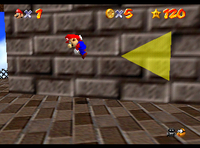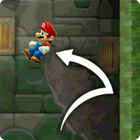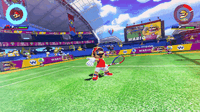Wall Jump: Difference between revisions
Pichufan93 (talk | contribs) No edit summary |
(→Names in other languages: Page number) |
||
| (223 intermediate revisions by more than 100 users not shown) | |||
| Line 1: | Line 1: | ||
[[ | [[File:Mario Wall Jumps SMS.png|thumb|Mario performing a Wall Jump as illustrated in a ''[[Super Mario Sunshine]]'' manual]] | ||
{{quote|While sliding down a wall, press {{button|wii|A}} to wall-jump! See how high [[Mario|you]] can get with this technique!|[[Boards (characters)|Board]]|[[Super Mario Galaxy 2]]}} | |||
The | The '''Wall Jump''' (or '''wall jump'''), also known as the '''Wall Kick''' (or '''wall kick'''), is a [[List of moves|special move]] that can be used by several [[List of characters|characters]], most notably [[Mario]]. The move is activated by [[jump]]ing towards a wall and hitting the jump button again upon colliding with the wall. If that is done in narrow passages, characters can jump between the walls to ascend to a higher [[platform]] or over an obstacle. | ||
==History== | |||
===''Super Mario'' series=== | |||
[[File:Bump Jump.png|thumb|left|Mario performing a Wall Jump in ''Super Mario 64'']] | |||
[[File:SM3DL-Mario Wall Jump Artwork.png|thumb|Mario performing a Wall Jump in ''[[Super Mario 3D Land]]'']] | |||
In many early games, before the implementation of the actual wall-jumping mechanic, maneuvers similar to the Wall Jump exist as [[glitch]]es. For example, in ''[[Super Mario Bros.]]'', if Mario lands on a wall on a 16×16 boundary (so that his foot is on the top corner of a [[block]]), the player is able to jump from that point with frame-perfect timing. Similar glitches also exist in ''[[Super Mario Bros. 3]]'', ''[[Super Mario World]]'', and ''[[Super Mario World 2: Yoshi's Island]]''. | |||
[[ | The Wall Jump itself was first implemented in ''[[Super Mario 64]]''. Here, if Mario jumps at a wall, he bounces off, but if the player presses {{button|N64|A}} as soon as Mario hits the wall, he kicks off it instead, ascending higher than usual. If the player presses {{button|N64|A}} too late, Mario simply falls down. The angle of the Wall Jump can also be adjusted, based on the angle Mario jumps at the wall. In games starting from ''[[Super Mario Sunshine]]'' onward, Mario slides down the wall, making wall-jumping easier and the timing of the jump adjustable. This characteristic carries over to ''[[Super Mario 64 DS]]'', where Mario is the only character that can wall-jump. Due to the {{button|DS|A}} and {{button|DS|B}} buttons having their functions swapped, the text box that appears after the player collects the [[Mario Cap]] for the first time provides incorrect controls. | ||
Starting from ''[[New Super Mario Bros.]]'' onwards, [[Luigi]] is able to wall-jump as well. In the [[New Super Mario Bros. (disambiguation)|''New Super Mario Bros.'' series]], Mario, Luigi, [[Yellow Toad (New Super Mario Bros. series)|Yellow Toad]], and [[Blue Toad (character)|Blue Toad]] are capable of wall-jumping. In ''[[New Super Luigi U]]'', [[Nabbit]] is also capable of wall-jumping. In ''New Super Mario Bros. U'' and ''New Super Luigi U'', the player can perform a [[Spin Jump]] while wall-jumping. | |||
In ''[[Super Mario Galaxy 2]]'', the [[Mailtoad]] mentions that [[Captain Toad]] has the ability to wall-jump, as he was able to scale a canyon in pursuit of [[The Chimp]] in the [[Fluffy Bluff Galaxy]]; however, Captain Toad is unable to jump at all in ''[[Super Mario 3D World]]'', ''[[Captain Toad: Treasure Tracker]]'' (and [[Captain Toad: Treasure Tracker (Nintendo Switch / Nintendo 3DS)|its Nintendo Switch and Nintendo 3DS ports of the same name]]), and ''[[Super Mario 3D World + Bowser's Fury]]'', likely due to his heavy backpack. [[Toad]], [[Princess Peach]], and [[Rosalina]] are able to wall-jump in ''Super Mario 3D World'' and ''Super Mario 3D World + Bowser's Fury''. | |||
[[File:SMR - Wall Jump.png|thumb|left|140px|Mario performing a Wall Jump in ''Super Mario Run'']] | |||
In ''[[Super Mario Run]]'', characters can wall-jump off the sides of walls and platforms when players tap the screen when they are both next to the wall and facing it. If the player does not jump immediately, they can still slide down. The wall jump itself changes the direction the player is facing, enabling them to wall jump off parallel walls. (Once the player lands on the ground, they change back to facing forward.) In a [[Tower]], Wall Jumping is critical because the player continues to face the other way after landing from a wall jump or sliding down a wall. This enables the player to go up the zigzagging layout. The character's upper body touching a ledge while facing it prompts [[Edge Climbing]], so at a ledge the player can only wall-jump before that move starts. Wall Jumps can defeat enemies while rising. The game's user interface in [[How to Play]] and [[Easy Mode]] clarifies that Wall Jumps cannot reach as high as normal jumps. The first three Wall Jumps done in a row have a blue star effect, meaning that in the Toad Rally mode they contribute to starting a [[Coin Rush (Super Mario Run)|Coin Rush]]. This resets when the player lands on the ground. [[Toad (species)|Toad]]s are impressed by consecutive Wall Jumps, so in the Toad Rally mode, doing so will cause a Toad to start cheering for the player. | |||
In ''[[Super Mario Maker]]'' (and [[Super Mario Maker for Nintendo 3DS|its 3DS version]]) and ''[[Super Mario Maker 2]]'', Mario, Luigi, Toad, and [[Toadette]] can all wall-jump, but only in the ''New Super Mario Bros. U'' and ''Super Mario 3D World'' styles. | |||
===''Mario vs. Donkey Kong'' series=== | |||
====''Mario vs. Donkey Kong 2: March of the Minis''==== | |||
[[Mini]]s can wall-jump against [[Wall Jump Bar]]s in ''[[Mario vs. Donkey Kong 2: March of the Minis]]'', and by approaching one, a starts moving against it automatically. If the player taps the Mini with the stylus before it slides off of the Wall Jump Bar, it performs a Wall Jump. | |||
====''Mini Mario & Friends: amiibo Challenge''==== | |||
[[File:MM&FaC WallJump.png|thumb|Mini Mario executing the Wall Jump in ''[[Mini Mario & Friends: amiibo Challenge]]'']] | |||
The Wall Jump is a special ability used by Mini Mario in ''[[Mini Mario & Friends: amiibo Challenge]]''. From a horizontal surface, Mini Mario will automatically stick to a wall and bounce off it, continuously jumping between it and any other wall until the toy reaches a platform. Wall Jumps are not performed if Mini Mario touches a wall as it walks up a slant or bounces from a [[Trampoline|Spring]]. | |||
This ability is essential in reaching Mini Mario's assigned [[Goal Door (Mario vs. Donkey Kong series)|door]] in Level 5, located at the top of the stage. After clearing the level through said door, Mini Mario gains access to the [[Boost Pad Bonanza]] set of levels, which make extensive use of the Wall Jump ability. | |||
===''Mario Superstar Baseball''=== | |||
The Wall Jump is a special fielding ability in ''[[Mario Superstar Baseball]]''. It is usable by Mario, Luigi, [[Bowser Jr.]], [[Baby Mario]], [[Baby Luigi]], and [[Toadette]]. When one of these characters jumps near a wall, they take a great leap off it, covering distance at a vertical angle. The move is used to catch low home run balls. In ''[[Mario Super Sluggers]]'', this special ability is absent, possibly replaced by the Buddy Jump move. | |||
===''Mario Tennis Aces''=== | |||
[[File:Blazing Wall Jump - Mario Tennis Aces.gif|thumb|left]] | |||
The Wall Jump is used by Mario during his [[Special Shot (Mario Tennis Aces)|Special Shot]], the Blazing Wall Jump, in ''[[Mario Tennis Aces]]''. | |||
===''Donkey Kong Jungle Beat''=== | |||
Wall-jumping is an ability in ''[[Donkey Kong Jungle Beat]]''. It is usable by the player character, [[Donkey Kong]], and operates similarly to its use in other games, the player must be constantly tapping the control stick or hitting the bongo in the direction of the wall to be able to slide down it. | |||
===''Super Smash Bros.'' series=== | |||
{{main-wiki|SmashWiki|Wall jump}} | |||
Wall-jumping appears in the [[Super Smash Bros. (series)|''Super Smash Bros.'' series]] as an ability usable by several {{iw|smashwiki|fighter}}s. Wall-jumping works by tilting the {{iw|smashwiki|control stick}} in the direction away from the {{iw|smashwiki|wall}} while against it. Since ''[[Super Smash Bros. Brawl]]'', some of these characters are able to {{iw|smashwiki|Wall cling|wall-cling}} as well, which allows them to stick to a wall for a few seconds as long as players hold the control stick in the direction facing the wall. Only six characters are able to wall-cling: [[Lucario]], [[Diddy Kong]], [[Squirtle]], [[Greninja]], [[Sheik]], and [[Bayonetta]]. | |||
Although [[Luigi]] was able to wall-jump in the E3 demo of ''[[Super Smash Bros. for Nintendo 3DS]]'', and despite his ability to wall jump in sidescrolling games of the ''Super Mario'' series since ''[[New Super Mario Bros.]]'', he cannot do so in the final game nor ''Super Smash Bros. Ultimate''. | |||
===''Princess Peach: Showtime!''=== | |||
One of [[Princess Peach|Peach]]'s transformations in ''[[Princess Peach: Showtime!]]'', [[Ninja Peach]], can use wall jumps, which is mandatory to perform in some sections of the three levels in which she appears, including to get out of the room where she first receives the transformation in the [[Ninjutsu: The Art of Rapids]] level. | |||
==Profiles== | |||
===''Super Mario Sunshine''=== | |||
*'''Instruction booklet description:''' ''Jump toward a wall then jump again as soon as Mario makes contact. Perform successive wall kicks between two walls to climb higher and higher.''<br>'''''NOTE!''' Never give up! Try pressing {{button|gcn|A}} even when sliding down walls!'' | |||
===''Super Mario 3D Land''=== | |||
{{multilang profile | |||
|type=website | |||
|EngA=Mario can do a long running leap to more easily clear wide gaps.<ref>The bio for [[Long Jump]] is mistakenly used instead.</ref> | |||
|EngE=Press the B Button (or the A Button) when sliding down a wall to perform a Wall Jump, which will cause Mario to kick off the wall and jump in the opposite direction. Performing repeated Wall Jumps can take Mario up to some very high places!}} | |||
===''Super Mario Maker for Nintendo 3DS''=== | |||
*'''Digital manual description:''' ''{{button|3ds|B}} against a wall midjump'' | |||
===''Super Mario Run''=== | |||
*Tips and Tricks: Wall Jump: Tap the screen just as you reach a wall, and you'll jump in the opposite direction | |||
*Tips and Tricks: Consecutive Wall Jumps: Jumping back and forth between walls will really impress the Toads! | |||
==Gallery== | |||
<gallery> | |||
TSMBM McDonald's Happy Meal ad b.jpg|Mario about to jump from a wall in a commercial for a {{wp|McDonald's}} [[Happy Meal]] tie-in with ''[[The Super Mario Bros. Movie]]'' | |||
</gallery> | |||
==Names in other languages== | |||
{{foreign names | |||
|Jpn=カベジャンプ | |||
|JpnR=Kabe janpu | |||
|Jpn2=カベキック | |||
|Jpn2R=Kabe kikku | |||
|JpnM=Wall Jump | |||
|Jpn2M=Wall Kick | |||
|ChiS=踢墙跳 | |||
|ChiSR=Tī Qiáng Tiào | |||
|ChiSM=Kick wall jump | |||
|ChiT=踢牆跳 | |||
|ChiTR=Tī Qiáng Tiào | |||
|ChiTM=Kick wall jump | |||
|Dut=Muursprong | |||
|DutM=Wall jump | |||
|FreA=Saut mural | |||
|FreAC=<ref>{{cite|language=fr|title=''Super Mario Galaxy 2'' instruction booklet, French side|date=2010|format=PDF|url=www.nintendo.com/consumer/gameslist/manuals/Wii_Super_Mario_Galaxy2_Fr.pdf|page=34|publisher=Nintendo of America|archive=https://web.archive.org/web/20120305032850/http://www.nintendo.com/consumer/gameslist/manuals/Wii_Super_Mario_Galaxy2_Fr.pdf|deadlink=yes}}</ref><ref>{{cite|title=''Super Mario 64 DS'' instruction booklet|language=fr|format=PDF|date=2005|url=fs-prod-cdn.nintendo-europe.com/media/downloads/games_8/emanuals/nintendo_ds_21/Manual_NintendoDS_SuperMario64DS_FR.pdf|page=56|publisher=Nintendo of Europe}}</ref><ref>''Super Mario 3D All-Stars'' actions menu (''Super Mario Sunshine.'' and ''Super Mario Galaxy.'')</ref> | |||
|FreA2=Saut au Mur | |||
|FreA2C=<ref>{{cite|date=2002|title=''Super Mario Sunshine'' instruction booklet|page=17|publisher=Nintendo of Europe|language=fr}}</ref> | |||
|FreA3=Rebond sur le mur | |||
|FreA3C=<ref>{{cite|date=1997|language=fr|title=''Super Mario 64'' instruction booklet|url=fs-prod-cdn.nintendo-europe.com/media/downloads/games_8/emanuals/nintendo_8/Manual_Nintendo64_SuperMario64_FR.pdf|format=PDF|page=50}}</ref> | |||
|FreA4=Impulsion | |||
|FreA4C=<ref>''Super Mario 3D All-Stars'' actions menu (''Super Mario 64'')</ref> | |||
|FreAM=Wall Jump | |||
|FreA2M=Jump on Wall | |||
|FreA3M=Bounce on the wall | |||
|FreA4M=Pulse | |||
|FreE=Saut mural | |||
|FreEM=Wall jump | |||
|Ger=Wandsprung | |||
|GerM=Wall Jump | |||
|Ita=Calcio su parete | |||
|ItaC=<ref>{{cite|title=''[[Super Mario 64]]'' European manual|page=31|language=it|publisher=Nintendo of Europe|date=1997}}</ref> | |||
|Ita2=Salto a parete | |||
|Ita3=Scalaparete | |||
|Ita3N=''Mini Mario & Friends: amiibo Challenge'' | |||
|ItaM=Wall kick | |||
|Ita2M=Wall jump | |||
|Ita3M=Wall-climb | |||
|Kor=벽차기 | |||
|KorR=Byeokchagi | |||
|KorM=Wall Kick | |||
|PorA=Salto escalada | |||
|PorAM=Climbing jump | |||
|PorA2=Impulso na Parede | |||
|PorA2C=<ref>{{cite|title=''Super Mario 64'' Brazilian instruction booklet|page=10}}</ref> | |||
|PorA2N=''Super Mario 64'' | |||
|PorA2M=Wall Impulse | |||
|PorE=Salto Ricochete | |||
|PorEM=Rebound Jump | |||
|PorE2=Salto na parede | |||
|PorE2N=''Super Mario Bros. Wonder'' | |||
|PorE2M=Jump on the wall | |||
|Rus=Прыжок от стены | |||
|RusR=Pryzhok ot steny | |||
|RusM=Wall jump | |||
|SpaA=Salto escalada | |||
|SpaAN=''Super Mario Odyssey'' | |||
|SpaA2=Salto Escalada | |||
|SpaA2N=''Super Mario Bros. Wonder'' | |||
|SpaAM=Climbing jump | |||
|SpaA2M=Climbing jump | |||
|SpaA3=Rebotar en la Pared | |||
|SpaA3C=<ref>{{cite|url=https://csassets.nintendo.com/noaext/image/private/t_KA_PDF/Wii_Super_Mario_Galaxy?_a=BATCtdAA0|type=PDF|title=''Super Mario Galaxy'' instruction booklet|page=56|language=en-us|date=2007|publisher=Nintendo of America}}</ref> | |||
|SpaA3M=Bounce on the Wall | |||
|SpaA4=Salto de Muro | |||
|SpaA4N=''New Super Mario Bros. U'' | |||
|SpaA4M=Wall Jump | |||
|SpaA5=Salto de la patada en la pared | |||
|SpaA5N=''Super Mario 64 DS'' | |||
|SpaA5M=Wall kick jump | |||
|SpaE=Salto Escalada | |||
|SpaEM=Climbing Jump | |||
}} | |||
==References== | |||
{{NIWA|SmashWiki=Wall jump}} | |||
<references/> | |||
{{navboxes| | |||
{{SM64}} | |||
{{SSBM}} | |||
{{Super Mario Sunshine}} | |||
{{DKJB}} | |||
{{MSB}} | |||
{{NSMB}} | |||
{{MVDK2MOTM}} | |||
{{SMG}} | |||
{{SSBB}} | |||
{{NSMBW}} | |||
{{SMG2}} | |||
{{SM3DL}} | |||
{{NSMB2}} | |||
{{NSMBU}} | |||
{{SM3DW}} | |||
{{SSB4}} | |||
{{MM&FaC}} | |||
{{SMM}} | |||
{{SMO}} | |||
{{SMM2}} | |||
{{SMBW}} | |||
{{PPS}} | |||
}} | |||
[[Category:Jumps]] | [[Category:Jumps]] | ||
[[Category:Moves]] | |||
[[Category:Donkey Kong Jungle Beat]] | |||
[[Category:Mario Baseball special moves]] | |||
[[Category:Mario Superstar Baseball]] | |||
[[Category:Mario vs. Donkey Kong 2: March of the Minis]] | |||
[[Category:New Super Luigi U moves]] | |||
[[Category:New Super Mario Bros. moves]] | |||
[[Category:New Super Mario Bros. 2 moves]] | |||
[[Category:New Super Mario Bros. U moves]] | |||
[[Category:New Super Mario Bros. Wii moves]] | |||
[[Category:Super Mario 3D Land moves]] | |||
[[Category:Super Mario 3D World moves]] | |||
[[Category:Super Mario 64 moves]] | |||
[[Category:Super Mario Galaxy moves]] | |||
[[Category:Super Mario Galaxy 2 moves]] | |||
[[Category:Super Mario Odyssey moves]] | |||
[[Category:Super Mario Sunshine moves]] | |||
[[Category:Super Smash Bros. Brawl]] | |||
[[Category:Super Smash Bros. for Nintendo 3DS / Wii U]] | |||
[[Category:Super Smash Bros. Melee]] | |||
[[de:Wandsprung]] | |||
[[it:Salto a parete]] | |||
Latest revision as of 23:35, February 15, 2025
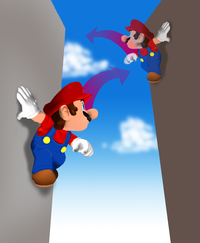
- “While sliding down a wall, press
 to wall-jump! See how high you can get with this technique!”
to wall-jump! See how high you can get with this technique!” - —Board, Super Mario Galaxy 2
The Wall Jump (or wall jump), also known as the Wall Kick (or wall kick), is a special move that can be used by several characters, most notably Mario. The move is activated by jumping towards a wall and hitting the jump button again upon colliding with the wall. If that is done in narrow passages, characters can jump between the walls to ascend to a higher platform or over an obstacle.
History[edit]
Super Mario series[edit]

In many early games, before the implementation of the actual wall-jumping mechanic, maneuvers similar to the Wall Jump exist as glitches. For example, in Super Mario Bros., if Mario lands on a wall on a 16×16 boundary (so that his foot is on the top corner of a block), the player is able to jump from that point with frame-perfect timing. Similar glitches also exist in Super Mario Bros. 3, Super Mario World, and Super Mario World 2: Yoshi's Island.
The Wall Jump itself was first implemented in Super Mario 64. Here, if Mario jumps at a wall, he bounces off, but if the player presses ![]() as soon as Mario hits the wall, he kicks off it instead, ascending higher than usual. If the player presses
as soon as Mario hits the wall, he kicks off it instead, ascending higher than usual. If the player presses ![]() too late, Mario simply falls down. The angle of the Wall Jump can also be adjusted, based on the angle Mario jumps at the wall. In games starting from Super Mario Sunshine onward, Mario slides down the wall, making wall-jumping easier and the timing of the jump adjustable. This characteristic carries over to Super Mario 64 DS, where Mario is the only character that can wall-jump. Due to the
too late, Mario simply falls down. The angle of the Wall Jump can also be adjusted, based on the angle Mario jumps at the wall. In games starting from Super Mario Sunshine onward, Mario slides down the wall, making wall-jumping easier and the timing of the jump adjustable. This characteristic carries over to Super Mario 64 DS, where Mario is the only character that can wall-jump. Due to the ![]() and
and ![]() buttons having their functions swapped, the text box that appears after the player collects the Mario Cap for the first time provides incorrect controls.
buttons having their functions swapped, the text box that appears after the player collects the Mario Cap for the first time provides incorrect controls.
Starting from New Super Mario Bros. onwards, Luigi is able to wall-jump as well. In the New Super Mario Bros. series, Mario, Luigi, Yellow Toad, and Blue Toad are capable of wall-jumping. In New Super Luigi U, Nabbit is also capable of wall-jumping. In New Super Mario Bros. U and New Super Luigi U, the player can perform a Spin Jump while wall-jumping.
In Super Mario Galaxy 2, the Mailtoad mentions that Captain Toad has the ability to wall-jump, as he was able to scale a canyon in pursuit of The Chimp in the Fluffy Bluff Galaxy; however, Captain Toad is unable to jump at all in Super Mario 3D World, Captain Toad: Treasure Tracker (and its Nintendo Switch and Nintendo 3DS ports of the same name), and Super Mario 3D World + Bowser's Fury, likely due to his heavy backpack. Toad, Princess Peach, and Rosalina are able to wall-jump in Super Mario 3D World and Super Mario 3D World + Bowser's Fury.
In Super Mario Run, characters can wall-jump off the sides of walls and platforms when players tap the screen when they are both next to the wall and facing it. If the player does not jump immediately, they can still slide down. The wall jump itself changes the direction the player is facing, enabling them to wall jump off parallel walls. (Once the player lands on the ground, they change back to facing forward.) In a Tower, Wall Jumping is critical because the player continues to face the other way after landing from a wall jump or sliding down a wall. This enables the player to go up the zigzagging layout. The character's upper body touching a ledge while facing it prompts Edge Climbing, so at a ledge the player can only wall-jump before that move starts. Wall Jumps can defeat enemies while rising. The game's user interface in How to Play and Easy Mode clarifies that Wall Jumps cannot reach as high as normal jumps. The first three Wall Jumps done in a row have a blue star effect, meaning that in the Toad Rally mode they contribute to starting a Coin Rush. This resets when the player lands on the ground. Toads are impressed by consecutive Wall Jumps, so in the Toad Rally mode, doing so will cause a Toad to start cheering for the player.
In Super Mario Maker (and its 3DS version) and Super Mario Maker 2, Mario, Luigi, Toad, and Toadette can all wall-jump, but only in the New Super Mario Bros. U and Super Mario 3D World styles.
Mario vs. Donkey Kong series[edit]
Mario vs. Donkey Kong 2: March of the Minis[edit]
Minis can wall-jump against Wall Jump Bars in Mario vs. Donkey Kong 2: March of the Minis, and by approaching one, a starts moving against it automatically. If the player taps the Mini with the stylus before it slides off of the Wall Jump Bar, it performs a Wall Jump.
Mini Mario & Friends: amiibo Challenge[edit]
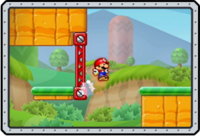
The Wall Jump is a special ability used by Mini Mario in Mini Mario & Friends: amiibo Challenge. From a horizontal surface, Mini Mario will automatically stick to a wall and bounce off it, continuously jumping between it and any other wall until the toy reaches a platform. Wall Jumps are not performed if Mini Mario touches a wall as it walks up a slant or bounces from a Spring.
This ability is essential in reaching Mini Mario's assigned door in Level 5, located at the top of the stage. After clearing the level through said door, Mini Mario gains access to the Boost Pad Bonanza set of levels, which make extensive use of the Wall Jump ability.
Mario Superstar Baseball[edit]
The Wall Jump is a special fielding ability in Mario Superstar Baseball. It is usable by Mario, Luigi, Bowser Jr., Baby Mario, Baby Luigi, and Toadette. When one of these characters jumps near a wall, they take a great leap off it, covering distance at a vertical angle. The move is used to catch low home run balls. In Mario Super Sluggers, this special ability is absent, possibly replaced by the Buddy Jump move.
Mario Tennis Aces[edit]
The Wall Jump is used by Mario during his Special Shot, the Blazing Wall Jump, in Mario Tennis Aces.
Donkey Kong Jungle Beat[edit]
Wall-jumping is an ability in Donkey Kong Jungle Beat. It is usable by the player character, Donkey Kong, and operates similarly to its use in other games, the player must be constantly tapping the control stick or hitting the bongo in the direction of the wall to be able to slide down it.
Super Smash Bros. series[edit]
- SmashWiki article: Wall jump
Wall-jumping appears in the Super Smash Bros. series as an ability usable by several fighters. Wall-jumping works by tilting the control stick in the direction away from the wall while against it. Since Super Smash Bros. Brawl, some of these characters are able to wall-cling as well, which allows them to stick to a wall for a few seconds as long as players hold the control stick in the direction facing the wall. Only six characters are able to wall-cling: Lucario, Diddy Kong, Squirtle, Greninja, Sheik, and Bayonetta.
Although Luigi was able to wall-jump in the E3 demo of Super Smash Bros. for Nintendo 3DS, and despite his ability to wall jump in sidescrolling games of the Super Mario series since New Super Mario Bros., he cannot do so in the final game nor Super Smash Bros. Ultimate.
Princess Peach: Showtime![edit]
One of Peach's transformations in Princess Peach: Showtime!, Ninja Peach, can use wall jumps, which is mandatory to perform in some sections of the three levels in which she appears, including to get out of the room where she first receives the transformation in the Ninjutsu: The Art of Rapids level.
Profiles[edit]
Super Mario Sunshine[edit]
- Instruction booklet description: Jump toward a wall then jump again as soon as Mario makes contact. Perform successive wall kicks between two walls to climb higher and higher.
NOTE! Never give up! Try pressing even when sliding down walls!
even when sliding down walls!
Super Mario 3D Land[edit]
- Website description:
- English (American):
Mario can do a long running leap to more easily clear wide gaps.[1] - English (British):
Press the B Button (or the A Button) when sliding down a wall to perform a Wall Jump, which will cause Mario to kick off the wall and jump in the opposite direction. Performing repeated Wall Jumps can take Mario up to some very high places!
- English (American):
Super Mario Maker for Nintendo 3DS[edit]
- Digital manual description:
against a wall midjump
Super Mario Run[edit]
- Tips and Tricks: Wall Jump: Tap the screen just as you reach a wall, and you'll jump in the opposite direction
- Tips and Tricks: Consecutive Wall Jumps: Jumping back and forth between walls will really impress the Toads!
Gallery[edit]
Mario about to jump from a wall in a commercial for a McDonald's Happy Meal tie-in with The Super Mario Bros. Movie
Names in other languages[edit]
| Language | Name | Meaning | Notes |
|---|---|---|---|
| Japanese | カベジャンプ[?] Kabe janpu |
Wall Jump | |
| カベキック[?] Kabe kikku |
Wall Kick | ||
| Chinese (simplified) | 踢墙跳[?] Tī Qiáng Tiào |
Kick wall jump | |
| Chinese (traditional) | 踢牆跳[?] Tī Qiáng Tiào |
Kick wall jump | |
| Dutch | Muursprong[?] | Wall jump | |
| French (NOA) | Saut mural[2][3][4] | Wall Jump | |
| Saut au Mur[5] | Jump on Wall | ||
| Rebond sur le mur[6] | Bounce on the wall | ||
| Impulsion[7] | Pulse | ||
| French (NOE) | Saut mural[?] | Wall jump | |
| German | Wandsprung[?] | Wall Jump | |
| Italian | Calcio su parete[8] | Wall kick | |
| Salto a parete[?] | Wall jump | ||
| Scalaparete[?] | Wall-climb | Mini Mario & Friends: amiibo Challenge | |
| Korean | 벽차기[?] Byeokchagi |
Wall Kick | |
| Portuguese (NOA) | Salto escalada[?] | Climbing jump | |
| Impulso na Parede[9] | Wall Impulse | Super Mario 64 | |
| Portuguese (NOE) | Salto Ricochete[?] | Rebound Jump | |
| Salto na parede[?] | Jump on the wall | Super Mario Bros. Wonder | |
| Russian | Прыжок от стены[?] Pryzhok ot steny |
Wall jump | |
| Spanish (NOA) | Salto escalada[?] | Climbing jump | Super Mario Odyssey |
| Salto Escalada[?] | Super Mario Bros. Wonder | ||
| Rebotar en la Pared[10] | Bounce on the Wall | ||
| Salto de Muro[?] | Wall Jump | New Super Mario Bros. U | |
| Salto de la patada en la pared[?] | Wall kick jump | Super Mario 64 DS | |
| Spanish (NOE) | Salto Escalada[?] | Climbing Jump |
References[edit]
- ^ The bio for Long Jump is mistakenly used instead.
- ^ 2010. Super Mario Galaxy 2 instruction booklet, French side (PDF). Nintendo of America (French). Page 34. Archived March 5, 2012, 03:28:50 UTC from the original via Wayback Machine.
- ^ 2005. Super Mario 64 DS instruction booklet (PDF). Nintendo of Europe (French). Page 56.
- ^ Super Mario 3D All-Stars actions menu (Super Mario Sunshine. and Super Mario Galaxy.)
- ^ 2002. Super Mario Sunshine instruction booklet. Nintendo of Europe (French). Page 17.
- ^ 1997. Super Mario 64 instruction booklet (PDF). French. Page 50.
- ^ Super Mario 3D All-Stars actions menu (Super Mario 64)
- ^ 1997. Super Mario 64 European manual. Nintendo of Europe (Italian). Page 31.
- ^ Super Mario 64 Brazilian instruction booklet. Page 10.
- ^ 2007. Super Mario Galaxy instruction booklet. Nintendo of America (American English). Page 56.
- Jumps
- Moves
- Donkey Kong Jungle Beat
- Mario Baseball special moves
- Mario Superstar Baseball
- Mario vs. Donkey Kong 2: March of the Minis
- New Super Luigi U moves
- New Super Mario Bros. moves
- New Super Mario Bros. 2 moves
- New Super Mario Bros. U moves
- New Super Mario Bros. Wii moves
- Super Mario 3D Land moves
- Super Mario 3D World moves
- Super Mario 64 moves
- Super Mario Galaxy moves
- Super Mario Galaxy 2 moves
- Super Mario Odyssey moves
- Super Mario Sunshine moves
- Super Smash Bros. Brawl
- Super Smash Bros. for Nintendo 3DS / Wii U
- Super Smash Bros. Melee
